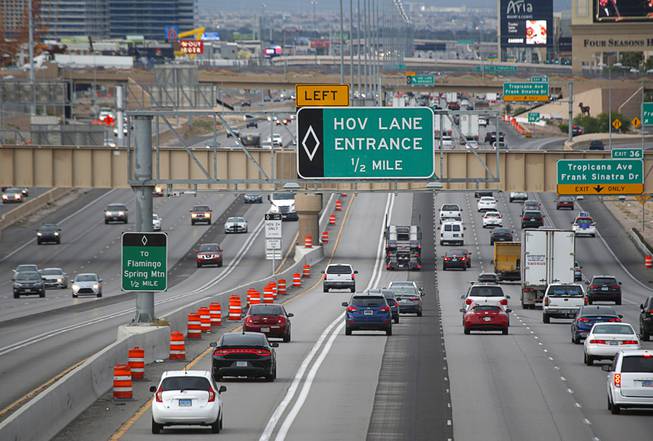
Cars use the High Occupancy Vehicle lane on northbound Interstate 15 near Sunset Road Wednesday, May 22, 2019.
Thursday, May 23, 2019 | 2 a.m.
Instead of the “I-15,” it’s time to start calling it the “We-15.”
Starting Monday, the busiest stretches of highway in the Las Vegas Valley debuted dedicated High Occupancy Vehicle lanes. Here’s what you need to know to drive in the fast lane:
Where are these new lanes?
They go along Interstate 15 in both directions between Silverado Ranch Boulevard in the south and the Spaghetti Bowl in the north. They also go along U.S. 95 in both directions farther north between Ann Road and the Spaghetti Bowl. By this summer, U.S. 95 will extend to Elkhorn Road.
What counts as High Occupancy?
Vehicles with two or more people (including babies); motorcycles (one or more riders); RTC buses (even without passengers), and emergency vehicles (even with lights off).
What doesn’t count?
Pets; trucks with more than two axles (no matter many riders).
24/7 enforcement:
Unlike other towns, where HOV lanes may only be in effect during rush hour, our HOV lanes will be on 24/7, because Las Vegas is a 24/7 town.
No crossing:
No matter how many passengers you have in your car, it’s always illegal to cross double-solid white lanes.
Fines:
Flying solo in the HOV lane will get you a $250 fine. For those who like to press their luck, there’s a 30-day “educational grace period.”
What about the I-15 express lanes?
According to Nevada Department of Transportation spokesman Tony Illia, “The two express lanes along I-15 are being converted into one general-purpose lane and one HOV lane. (However, there are brief portions with one thru HOV lane and one HOV exit lane).”
How can riders stay up-to-date amid all these road changes?
NDOT provides info to third-party GPS providers, such as Google and Apple maps, but the providers update their maps on their own time. For the most up-to-date info, use Waze, which works directly with NDOT and RTC. For info direct from the source, visit NVRoads.com or call 511.
Why did NDOT choose HOV lanes over more general-purpose lanes?
“Traditional freeway expansion increasingly faces tough hurdles like limited right-of-way, funding, and federal environmental rules, thereby limiting the ability to endlessly build infrastructure,” NDOT’s Illia says. “We have been adding travel lanes to Interstate 15 for 50 years. However, the added lanes become instantly clogged upon completion due to ever-increasing traffic. … As such, Nevada’s transportation department must use every tool available to combat gridlock, including carpooling.”
Do HOV lanes really help ease gridlock?
“High Occupancy Vehicle (HOV) or carpool lanes carry more people using fewer cars for better air quality through less emissions,” Illia says. “Carpooling is safer and less stressful, too, with fewer cars cutting in-and-out of lanes. Consider that carpooling reduces commute times with higher travel speeds and fewer delays since vehicles otherwise stuck in general traffic are removed for increased capacity.”
